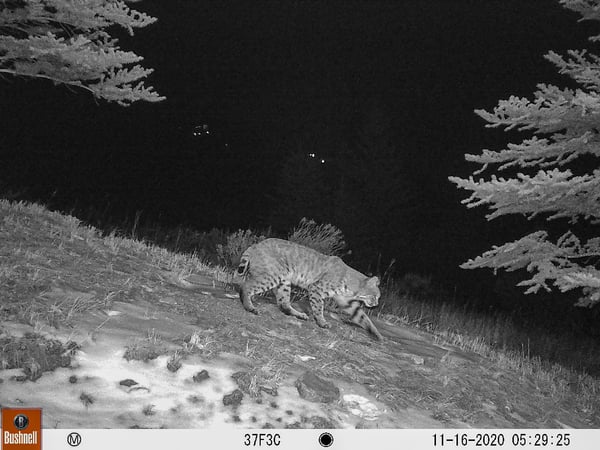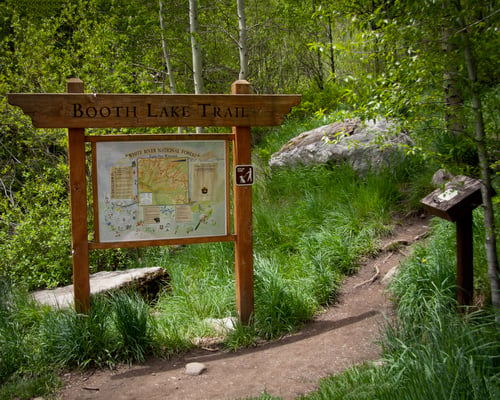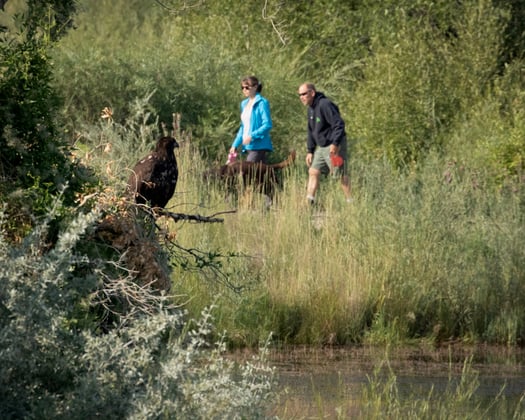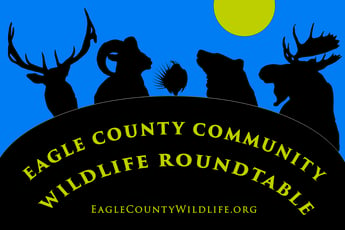This article is from the Eagle County Community Wildlife Roundtable.
Text by Jacci McKenna
Photographs by Rick Spitzer (except as noted.)
Living Our Values: Respect Wildlife – What Does That Mean?
Several weeks ago the Eagle Brush Creek Pavilion parking lot was filled with cars. The event? Elk grazing along Brush Creek. People took photos, kids were excited, and a CPW staff member was there to ensure nobody got too close. We, the people of Eagle County, love to see wildlife. Whether it’s the bighorn in East Vail or the bald eagles soaring over rafters on the Colorado River everyone has a better day when they see wildlife. Who doesn’t smile when they see pictures of Bobcats on the front page of the Vail Daily?
The resident herd of bighorn in East Vail is under a lot of civic pressure due to proposed development. There is now fencing to keep the animals off the nearby roads.
Our community survey “Conservation at the Intersection: Examining resident’s perceptions of and preferences for wildlife outdoor recreation and development”, performed by Mike Quartuch, Ph.D., CPW Human Dimensions Specialist/Researcher and two CSU graduate students, Ryan Fitz and John Kutrz; scientifically confirms we value wildlife and want to protect them so they can thrive for generations into the future. Sustaining wildlife populations is important to Eagle County residents and respondents want the county to prioritize the protection of critical wildlife habitat through their policies and actions. For more information, go to
https://cpw.state.co.us/Documents/Research/SocialScience/22-CPW-Tech-Report-60-Conservation-Intersection-Eagle-MRQ.pdf
How can we make those values a reality? In a nutshell, if we do four things, we can make a real difference: adhere to trail closures, keep your distance, keep dogs & cats leashed, and keep your trash inside until trash pick-up day.
Many of our valleys in Eagle County are critical winter range for deer and elk. When the snow gets deep at higher elevations, they migrate to the valleys in search of food and water. Every calorie matters. They need to stay warm and sustain themselves on stored fat and the few morsels available to eat. Foraging is hard. Food isn’t nutrient rich in the winter. Any disturbance could result in mothers not carrying their babies to term, being more susceptible to predation or even death. Adhering to trail closures is essential to minimize disturbance which increases their chances of survival through the winter.

Wildlife is wandering all the neighborhoods in Eagle County. Citizens should do what they can to not make their house and gardens an attractant.
During winter months, I am lucky to see what I call the evening processional when deer and elk come through the area to Brush Creek to drink. There are busy roads, trails and a dog park they have to navigate to make it to the creek. Recently I watched as a responsible dog owner kept her leashed German Shepard from chasing the elk. The dog was barking loudly and the elk started to turn and run. She turned around to take the dog in a different direction so the elk could continue their journey. She lived her value to protect wildlife and her actions made a difference. The elk turned back around and cautiously proceeded to the creek. If an elk stops what it’s doing to look at you, its heart rate is elevated and you’re too close. They’re burning calories they need to survive the winter. Keep your distance.
As winter ends, we begin a new season. Spring is a time of new birth; many species have their young and are busy caring for them. You may be raring to go and hike or bike your favorite trails. But first, check to make sure they’re open at Vail Valley Trail Maps & Conditions - Vail Valley Mountain Trails Alliance (
vvmta.org). Trail closures are designed to ensure wildlife have the privacy they need to survive tough winter months and to successfully give birth in the spring. This maximizes babies’ chances of survival.

Many trails have a Wildlife Trail Ambassador that work to educate trail users about how they can interact in the environment and do no harm.
How would you feel if a stranger was in your delivery room? Only family is allowed to be there. Wildlife deserves the same respect. Spring is also a time for birds to migrate and nest. Unfortunately bird populations are plummeting state-of-the-birds-2022-spreads.pdf (
stateofthebirds.org) . Did you know domestic free-ranging cats are a significant source of bird mortality? The Smithsonian estimates 2.4 billion birds and 12.3 billion mammals are killed in the US by domestic cats each year Smithsonian Insider – Cats kill 2.4 billion birds annually | Smithsonian Insider.
The Polish Academy of Sciences, a respected scientific institute, has classified domestic cats as an “invasive species” because of the damage they cause to birds and other wildlife. Keep your cats leashed or inside. The birds, squirrels, mice and voles thank you as will hawks, owls, badgers and foxes who rely on them for food. Every species is needed to balance the ecosystem, if one link in the chain is impacted, other species are at risk.
In springtime bears come out of hibernation, mothers with babies in tow. Hibernation takes its’ toll. Male black bears lose an estimated 15-30% of their body weight and lactating females up to 40% Bear Essentials of Hibernation | NOVA | PBS so they’re hungry! Our trash can be an enticing food source and irresistible if easily accessed. Put your trash out on the morning of pick-up and bring cans inside the same day. As Ben Franklin would say – an ounce of prevention is worth a pound of cure. Keeping bears wild and out of our neighborhoods is something we can all do to deliver on our values.
.jpeg?width=500&height=386&name=SpilledTrash%20(1).jpeg)
Trash that is not handled correctly may become an attractant that invites wildlife into our neighborhoods. Be Bear Aware. (Photo by Allan Finney)
What do you see when you look into the future? Will we have abundant and healthy wildlife populations gracing us with their presence? We are at a tipping point; wildlife populations are in steep decline and across the globe species are being lost to extinction at an alarming rate. The state of wildlife in our community is dire. In recent decades CPW has seen significant reductions and changes in the health of deer and elk populations. We humans are a primary contributor in determining the health and abundance of a wildlife population. Many areas that once provided or still provide critical habitat and corridors for wildlife have been replaced or influenced by where we live, work and play.
Will our grandchildren know what an elk is because wildlife thrives in our community or will they need to visit a national park? Since sustaining wildlife populations and prioritizing the protection of critical wildlife habitat is what we value, it’s up to us: adhere to trail closures, keep our distance, keep dogs & cats leashed and put trash out only on the day of pick-up. Each of us as individuals and together as a community we can make a difference for wildlife. Now is the time to act, tomorrow is too late!
You can also get involved by talking with your government officials about land use and development decisions. Habitat loss, degradation, and fragmentation are significant contributors to wildlife decline, so speak up to ensure development and recreation trails do not occur in critical wildlife habitat and migration corridors. Another way to preserve habitat is through organizations like the Eagle Valley Land Trust.
Jacci McKenna
An environmentalist and wildlife advocate. Community Representative on the Education Committee of the Eagle County Community Wildlife Roundtable.
======================================
The Eagle County Community Wildlife Roundtable is a collaborative partnership with the White River National Forest, Colorado Parks and Wildlife, Bureau of Land Management, local government entities, community members, and citizen scientists. The purpose of the Eagle County Community Wildlife Roundtable is to gather a group of diverse stakeholders in the valley to understand and address issues facing wildlife populations. Together we will identify a shared vision and realistic actions that the community can rally around to support wildlife. We want to leverage diverse values, creativity, and resources to move toward positive action.
======================================





.jpeg?width=500&height=386&name=SpilledTrash%20(1).jpeg)




